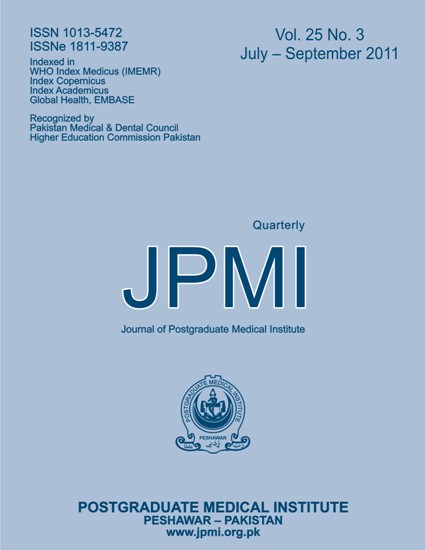OUTCOME OF OPEN VERSUS LAPROSCOPIC APPENDICECTOMY IN DEPARTMENT OF SURGERY, LADY READING HOSPITAL, PESHAWAR
Main Article Content
Abstract
Objective: To compare safety and benefits of laparoscopic versus open appendicectomy in a randomizedcontrol clinical trial.Methodology: Between January 2008 and October 2009 one hundred and twenty patients (86 male and 34female) with suspected acute appendicitis were assigned either to laparoscopic [n=60] or open [n=60]appendicectomy. Surgical technique was standardized for both laparoscopic and open procedure. Thepatients were analyzed in terms of the following aspects and findings; operation time, postoperative pain,intra and post operative complications, hospital stay and return to normal daily activities.Results: There was no mortality. Wound infection (8.3%) and intra-abdominal abscess (11.6%) formationrate was significantly higher in open group than in the laparoscopic group (1.6%) and (3.3%) respectively.Postoperative pain scores (assessed by a pain distress variable, indicated on visual linear scale 0 to 10and a pain activity scale, indicated on visual linear scale 0 to 10) was significantly lower in laparoscopicgroup. Hospital stay was significantly shorter in laparoscopic group (p<0.0353) and mean operation timewas similar in both groups. One patient (1.6%) was converted from laparoscopic to open appendicectomydue to diffuse pelvic adhesions.Conclusion: Though operation time was same but complications, pain and hospital stay was less in theLaparoscopic group.
Article Details
How to Cite
1.
Jan WA, Rehman Z ur, Khan SM, Ali G, Qayyum A, Mumtaz N. OUTCOME OF OPEN VERSUS LAPROSCOPIC APPENDICECTOMY IN DEPARTMENT OF SURGERY, LADY READING HOSPITAL, PESHAWAR. J Postgrad Med Inst [Internet]. 2011 Oct. 14 [cited 2025 Dec. 13];25(3). Available from: https://jpmi.org.pk/index.php/jpmi/article/view/1171
Issue
Section
Original Article
Work published in JPMI is licensed under a
Creative Commons Attribution-NonCommercial 2.0 Generic License.
Authors are permitted and encouraged to post their work online (e.g., in institutional repositories or on their website) prior to and during the submission process, as it can lead to productive exchanges, as well as earlier and greater citation of published work.


